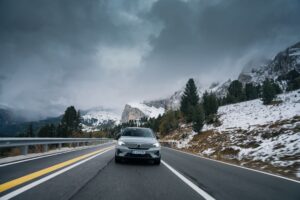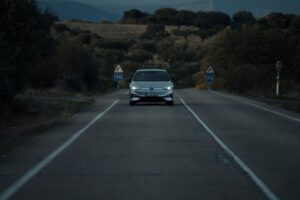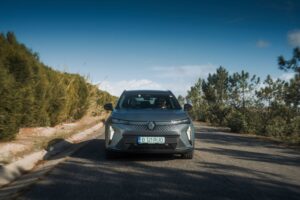We arrived at the hotel in the evening. It was raining, and on the “last hundred meters” I only had eyes for the apexes. Yes, after a few hundred kilometers of highway, when you discover a bit of Latinity lying in the way, you abandon censorship. Plus, there’s some S Line and quattro badging on our Q6, so we’ve let this GT express itself a bit. And if I may still be allowed to plead an ‘indulgence’, the destination of day four was Fusch, wince a little, even if the ‘s’ is in the middle rather than at the end.

This morning when I looked around I realized that I had arrived where clouds are born. A surreal timelessness in the way they slowly climbed high. And if I’ve imposed anything on myself in EUROCHARGE by Schaeffler, it’s the recklessness of stopping for a moment longer with my eyes on the beautiful, to indulge in this luxury. So I stepped out onto the hotel balcony and contemplated.
And because I started my day so well, because the rain didn’t hold back – by the way, I love the rain. Because at the start of the day some of our route plans were compromised by the authorities closing the mountain roads, I set out to take advantage.
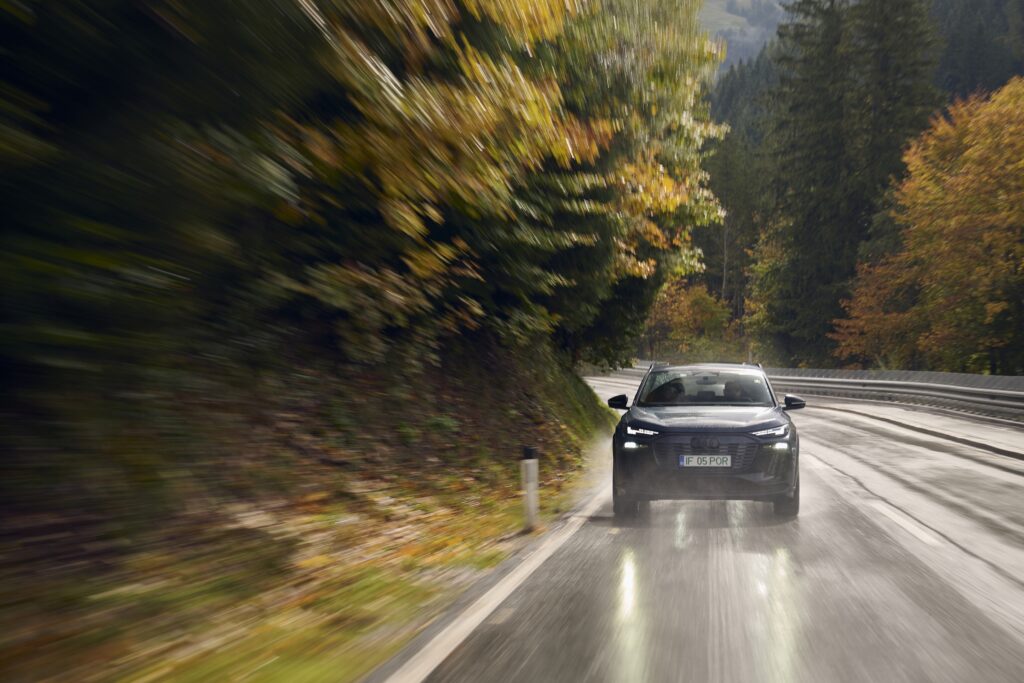
I convinced my EUROCHARGE colleague, Gabriel Nica, that it is essential that he drives today and I satisfied my psychologist appointment. Not that I have many conflicts, but the ones I do have, it’s good to keep an eye on them. Psychologist? Audi Q6 e-tron front-right seat. A bit harsh with me, I think he has some “unresolved” issues too, but it’s precisely his slight firmness that has kept me from slipping into the abyss.
Blessing of the rain
The rain that Tudor Rus complained about in the previous report, a blessing. It has further cleansed an atmosphere to that level that rivals mountain streams. And because we’re on a tour with electric models, when you’re not really audibly bothered by combustion, we took advantage of the Bang & Olufsen audio system – superbly calibrated, and played the latest Eric Clapton album – Meanwhile, released the day before.
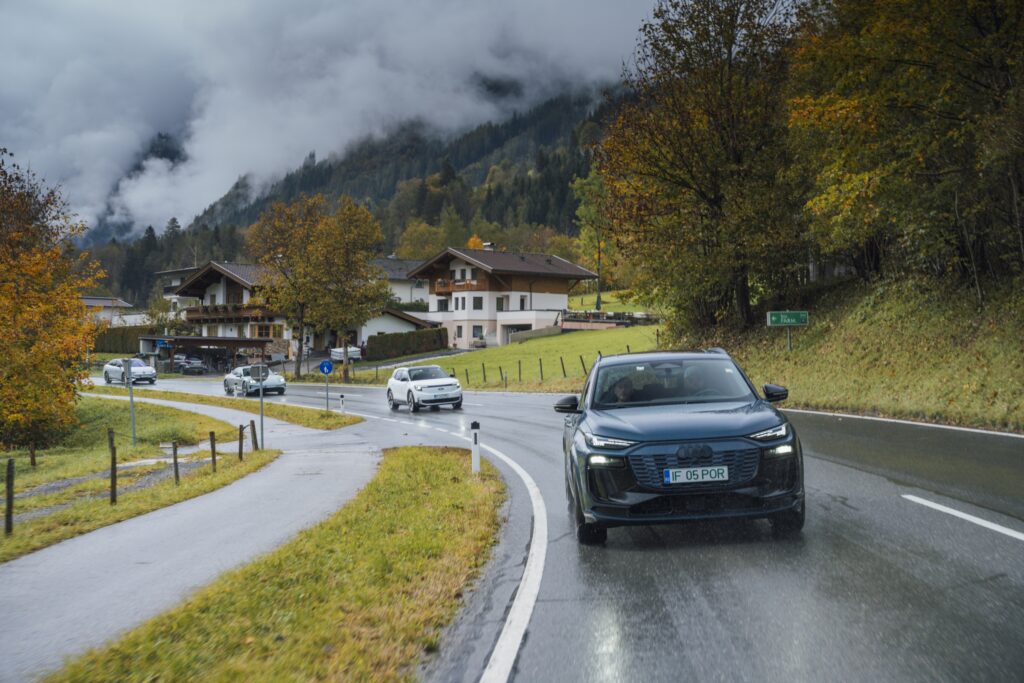

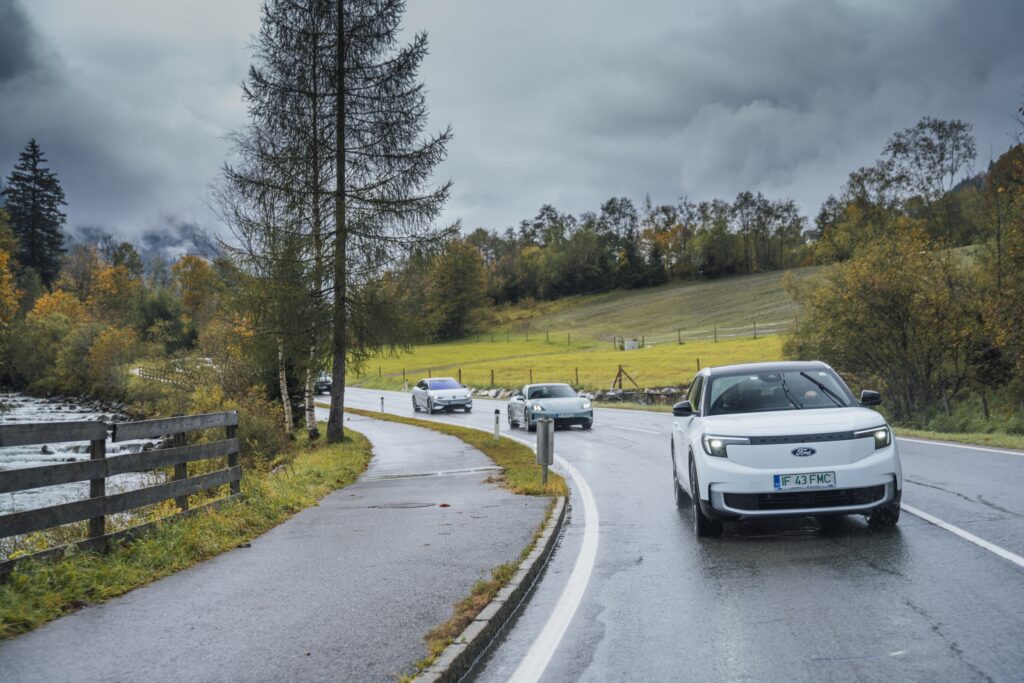
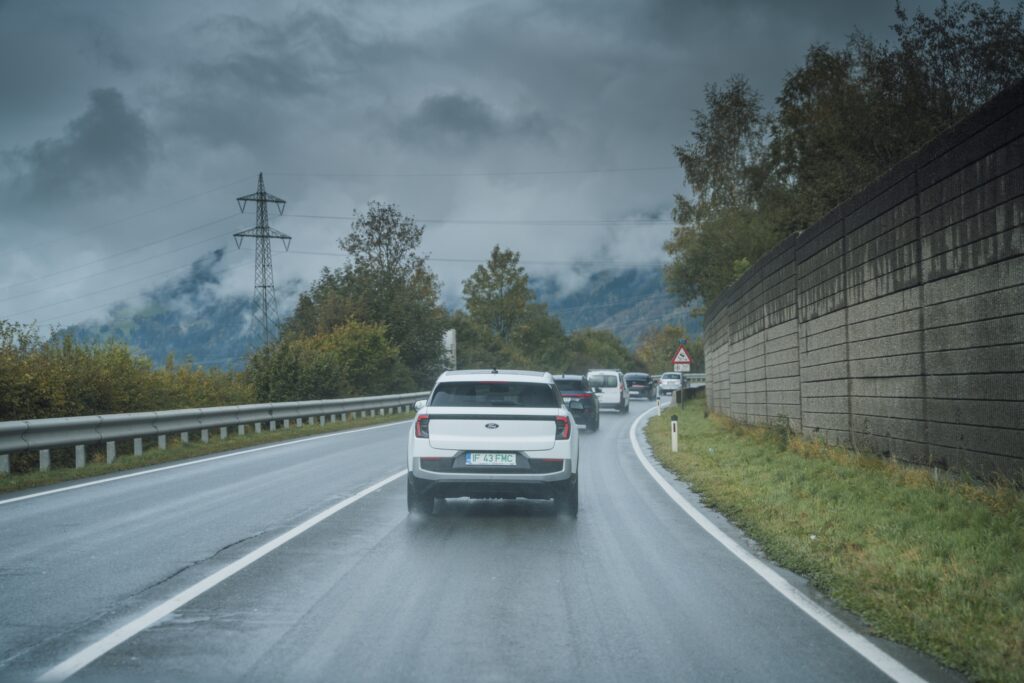
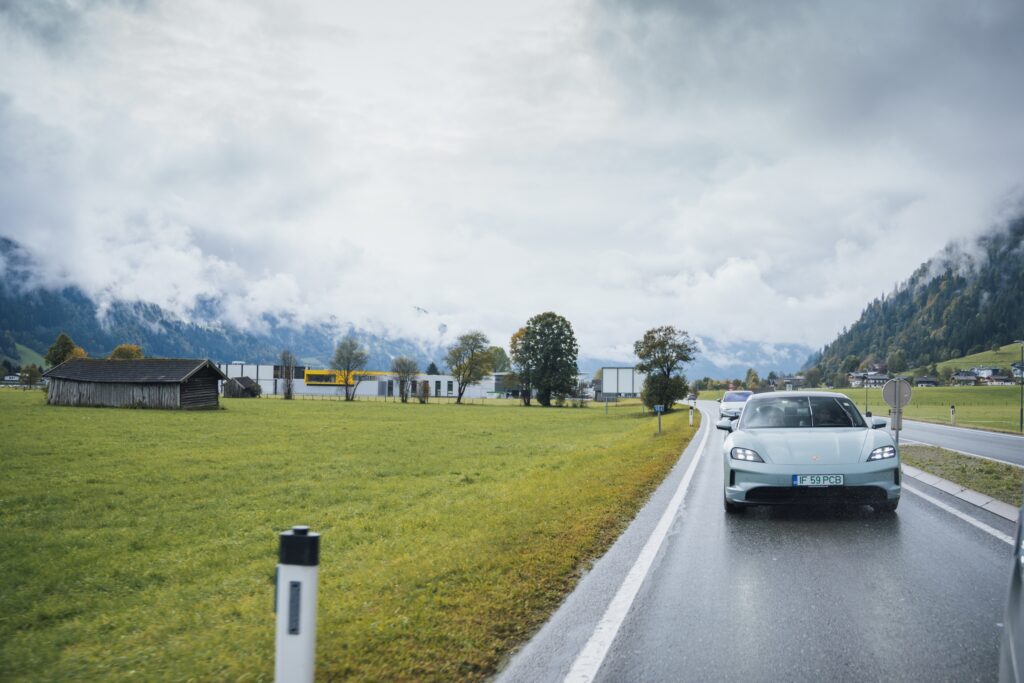
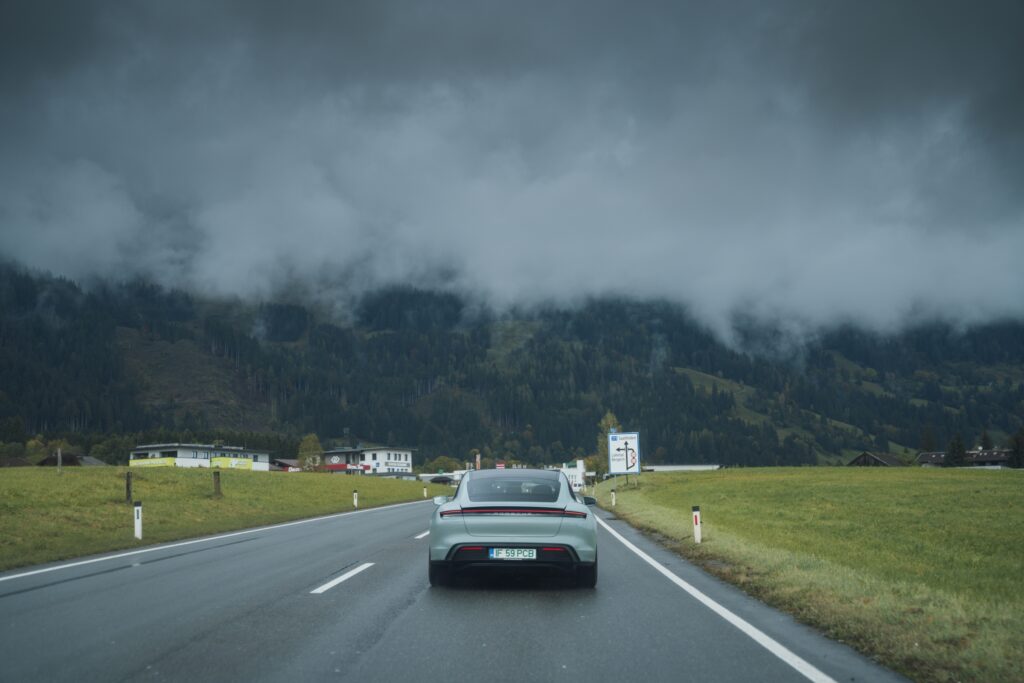
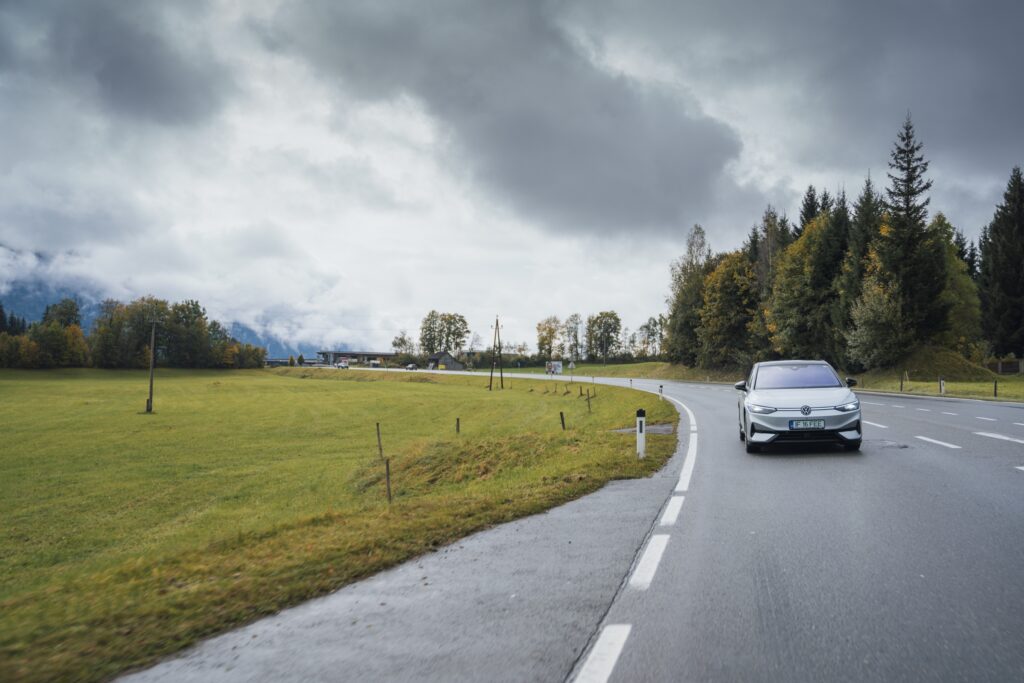
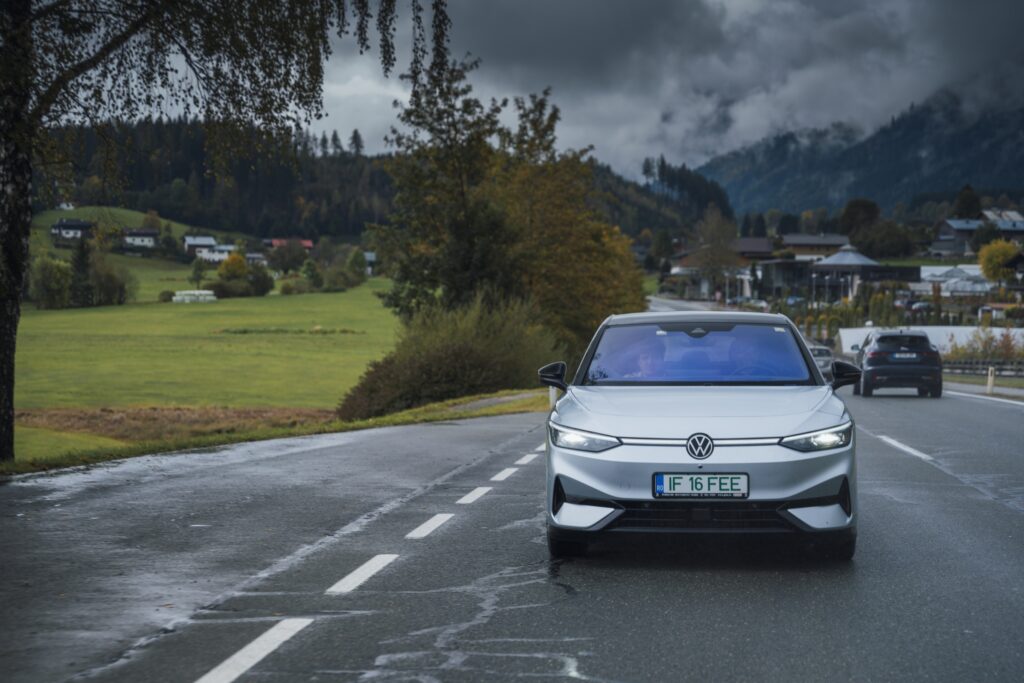
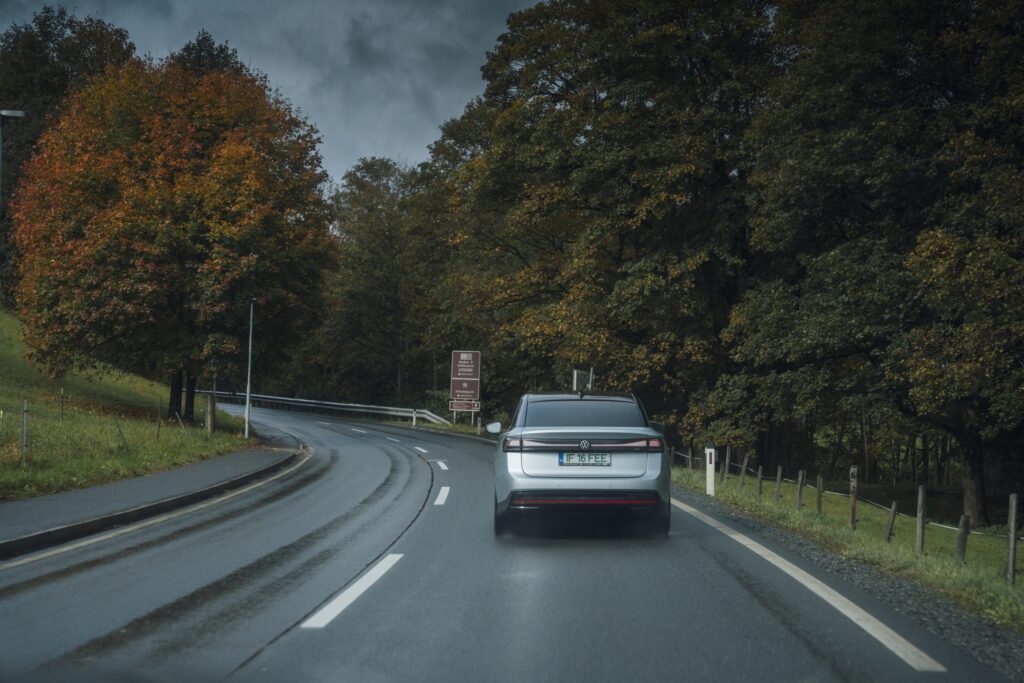
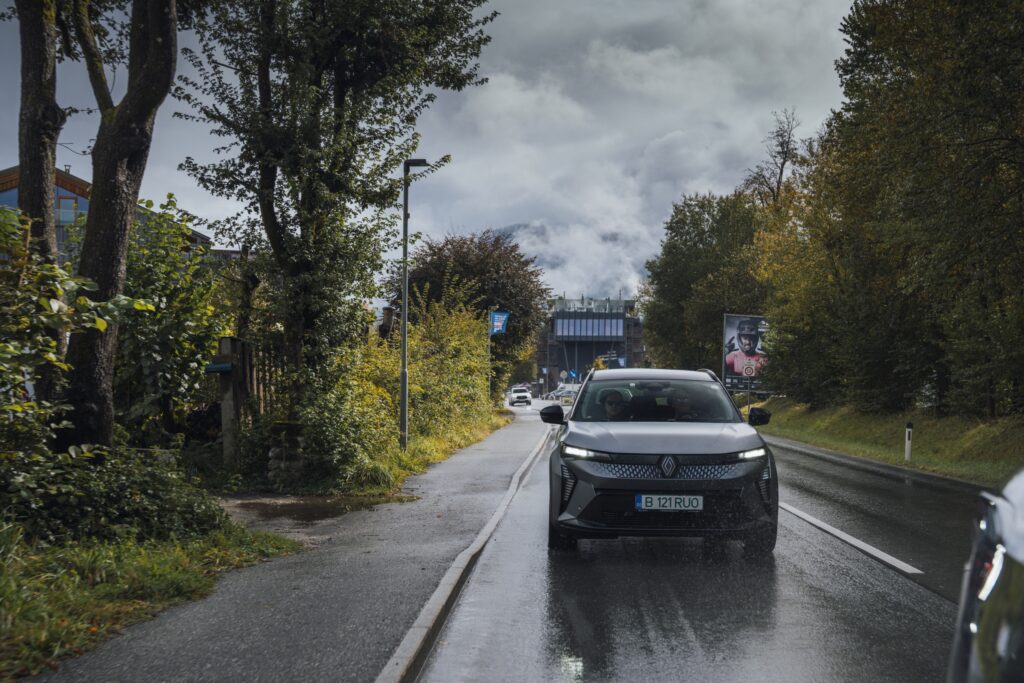
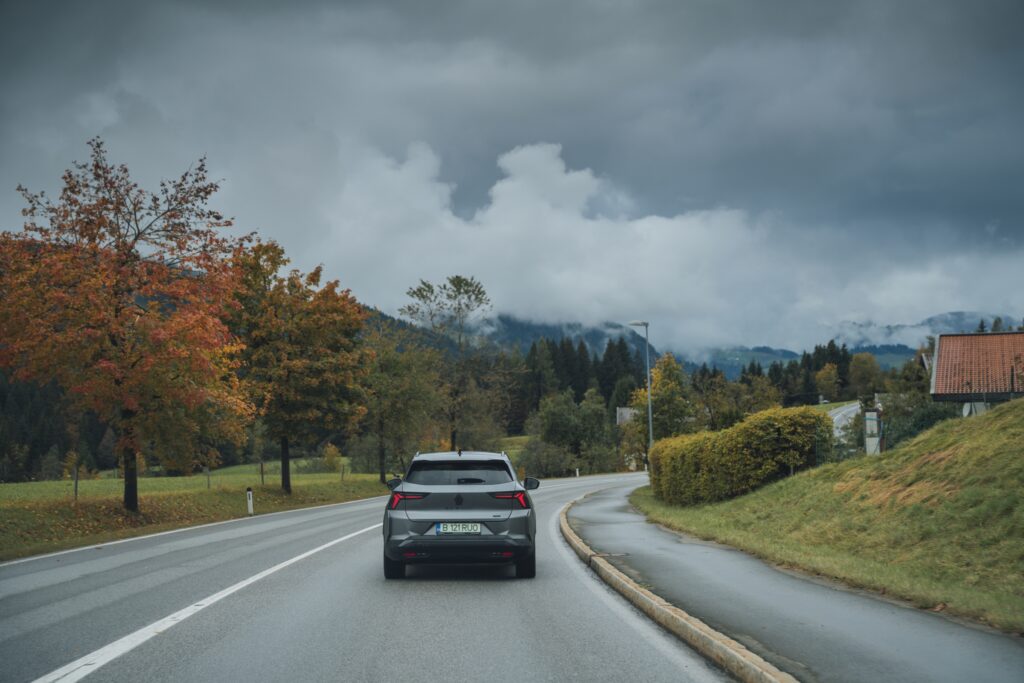
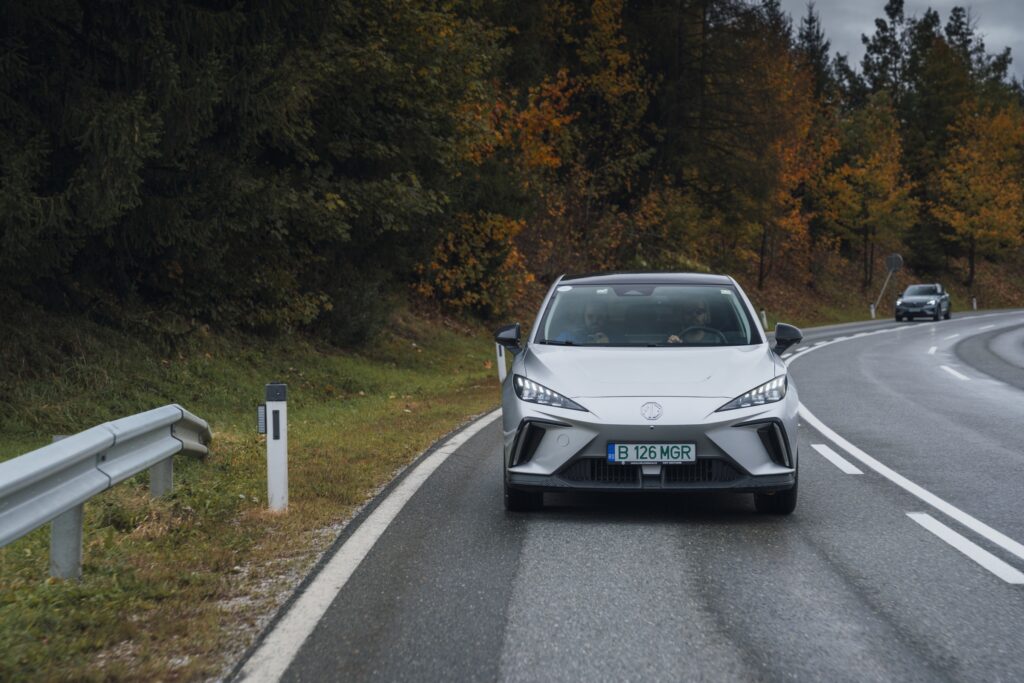

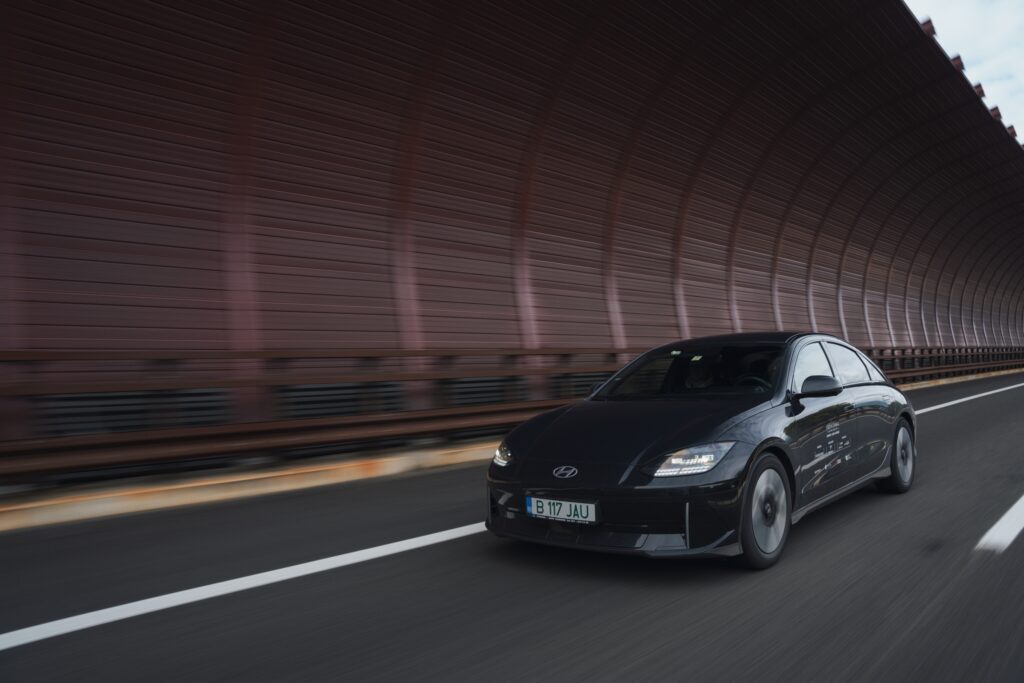
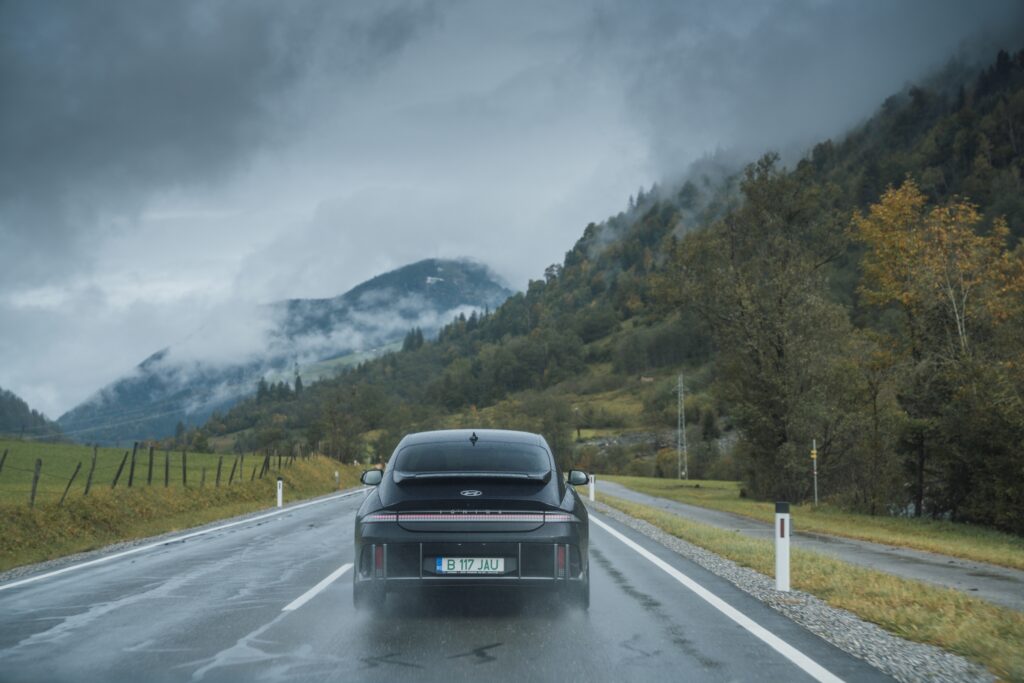
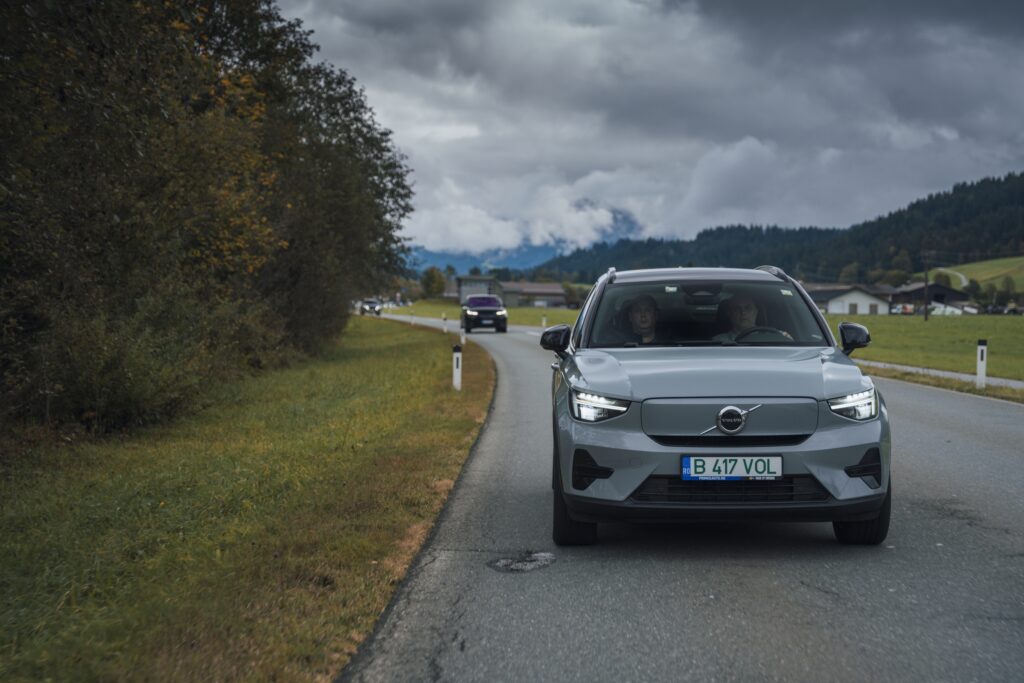
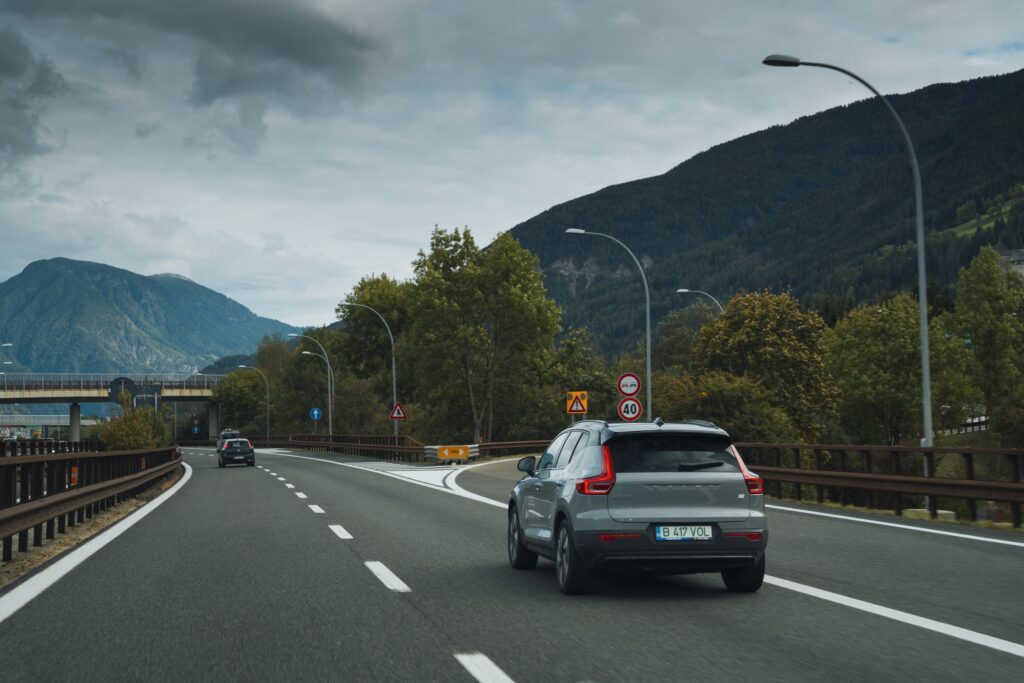
The epic thread of the session was Austrian landscapes. From Fusch we started Watterns. And purely by chance I remembered that we were in the land of Swarovski crystals. In Wattens is the production facility, and a 20-minute drive down the E60 is Swarovski Kristallwelten – Swarovski’s crystal world. It’s a crystal-themed amusement park, opened in 1995, the 100th anniversary of the opening of the Wattens production plant. It’s a place where the human eye can enjoy 576 megapixels.
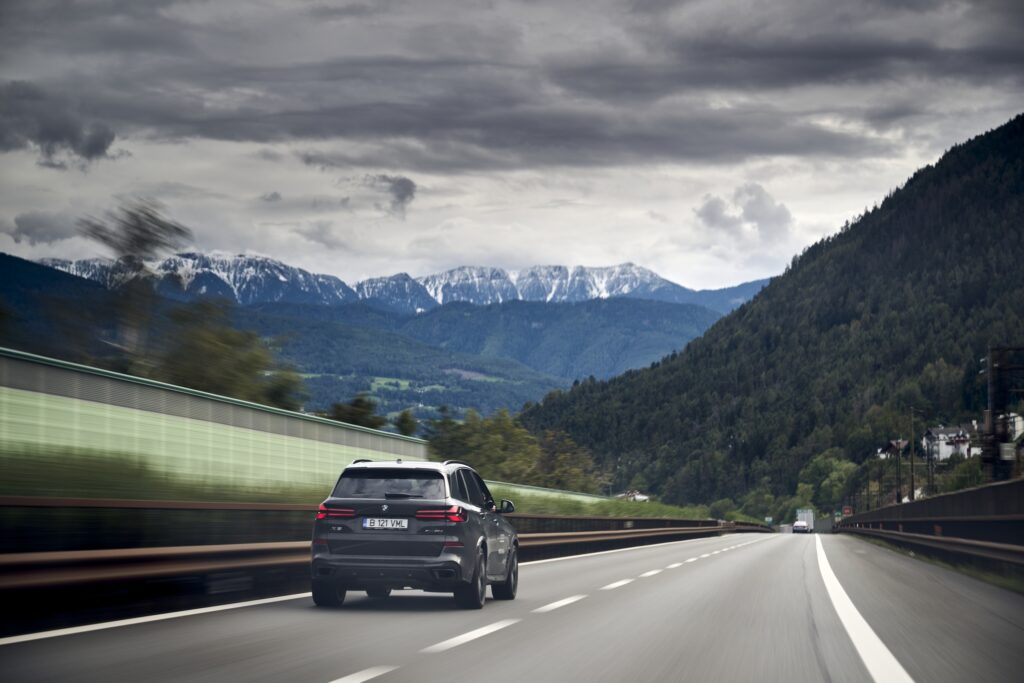
And speaking of pixels, and I can’t help but think of the photo/video team. This year they have an extremely difficult task in documenting this tour. They have to go ahead to meet up with them at key points. And that’s because it’s a tour where our electrics aren’t running contemplatively, we’re running 85-90% at the legal top speed.
Where the clouds reach
Next destination of the day – the Ionity station on the Brenner Pass. By there I couldn’t help but take a long look over my left shoulder and remember the Hintertux Glacier, visited two years ago. One of Austria’s most popular glaciers, accessible by cable car, and one of only two places in the world where you can ski 365 days a year. The second place is Zermatt in Switzerland.
Why? Because having lunch there I can’t say that’s a mature justification, I’ll just say that we were curious to see what a parking lot with 18 350 kW stations looked like. And obviously, not coincidentally, there’s also a big Outlet Outlet there, so we wanted to sample a lesson in civilization.
I’ll let you calculate what total power is available in that parking lot. We arrived last in the group with our Audi Q6 and found all the stalls occupied. We sat in line, waited. You see that painful part of civility when owners of cars put on charge show up at the car when the battery has reached the desired level. Whether that’s 80% (on average) or towards 100%. People use technology, check the charge level in apps. I’ve never seen a car run with a fully charged battery and block a station. How long did we wait? 10 minutes until a spot opened up for us.


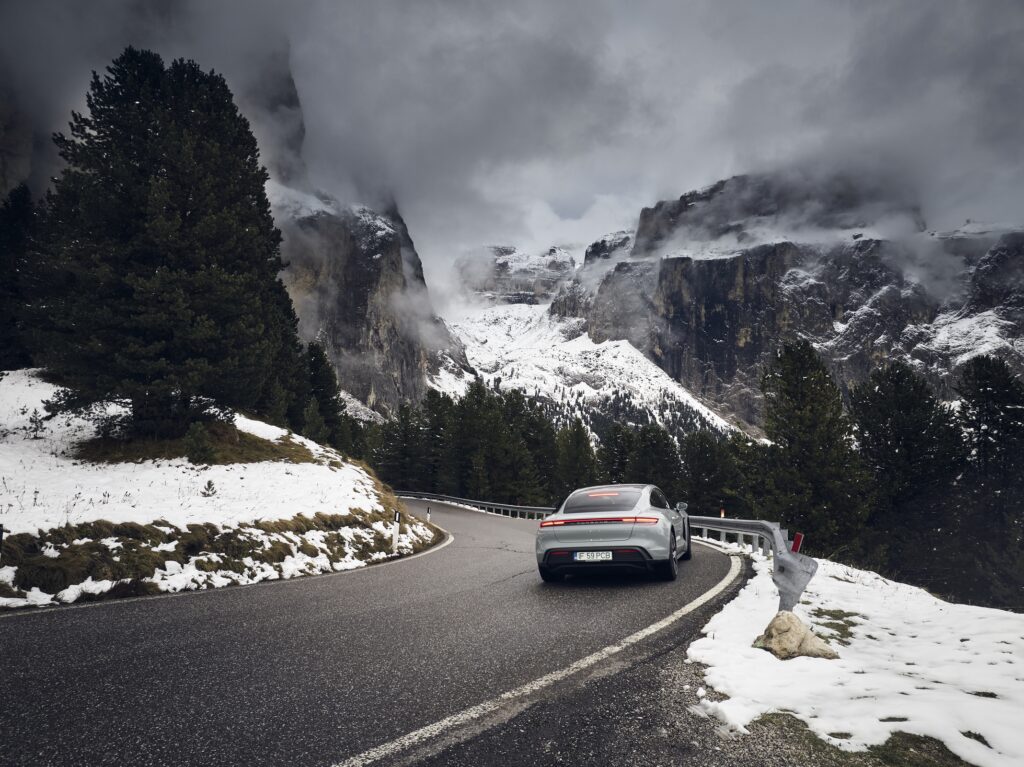


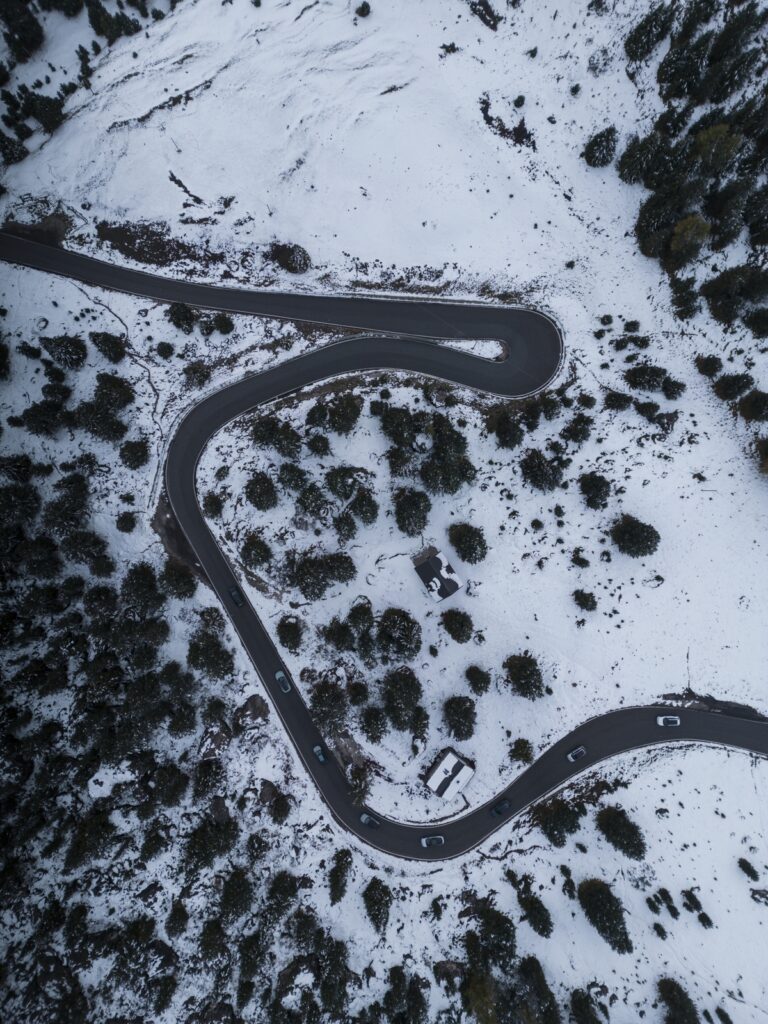
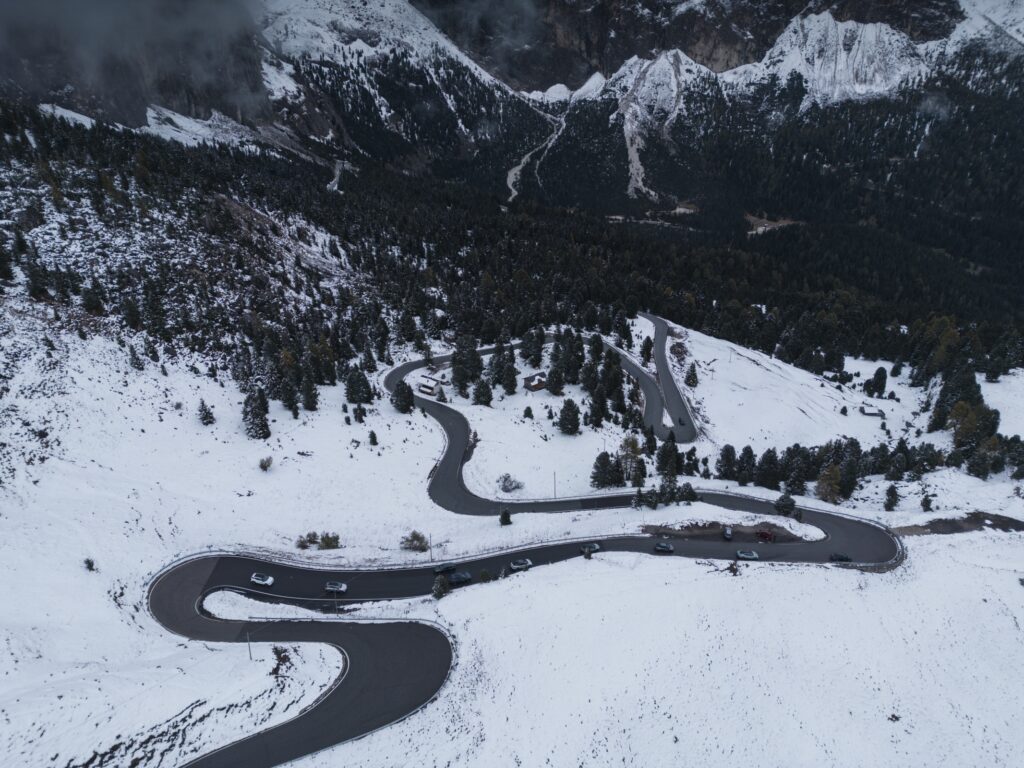
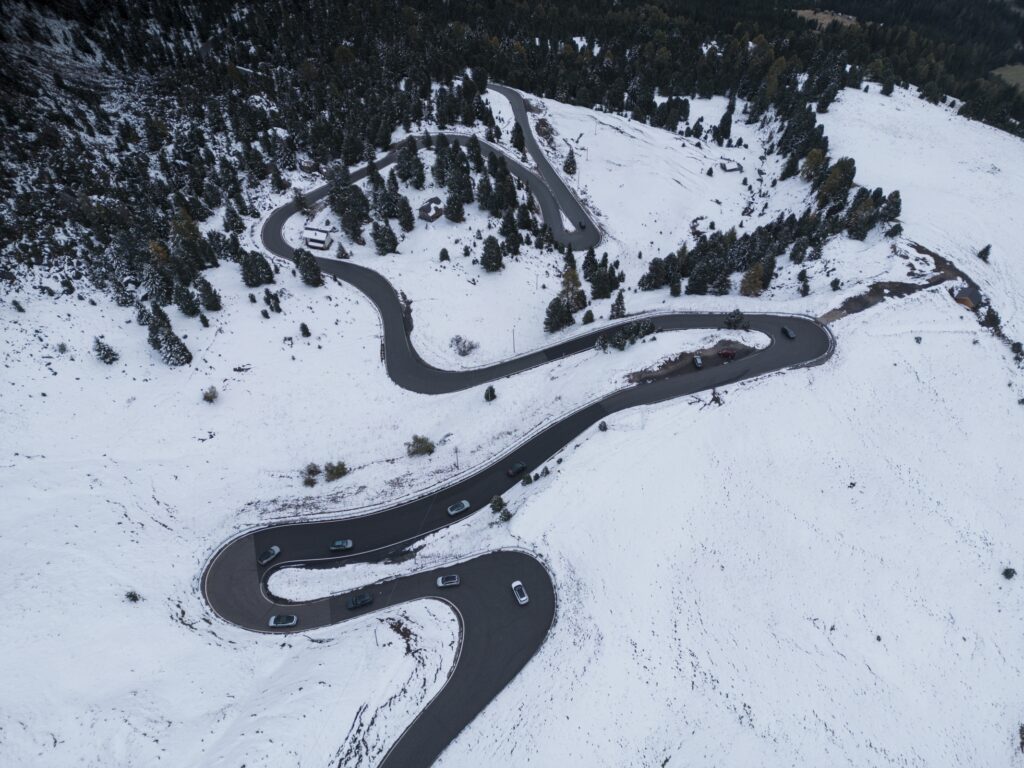

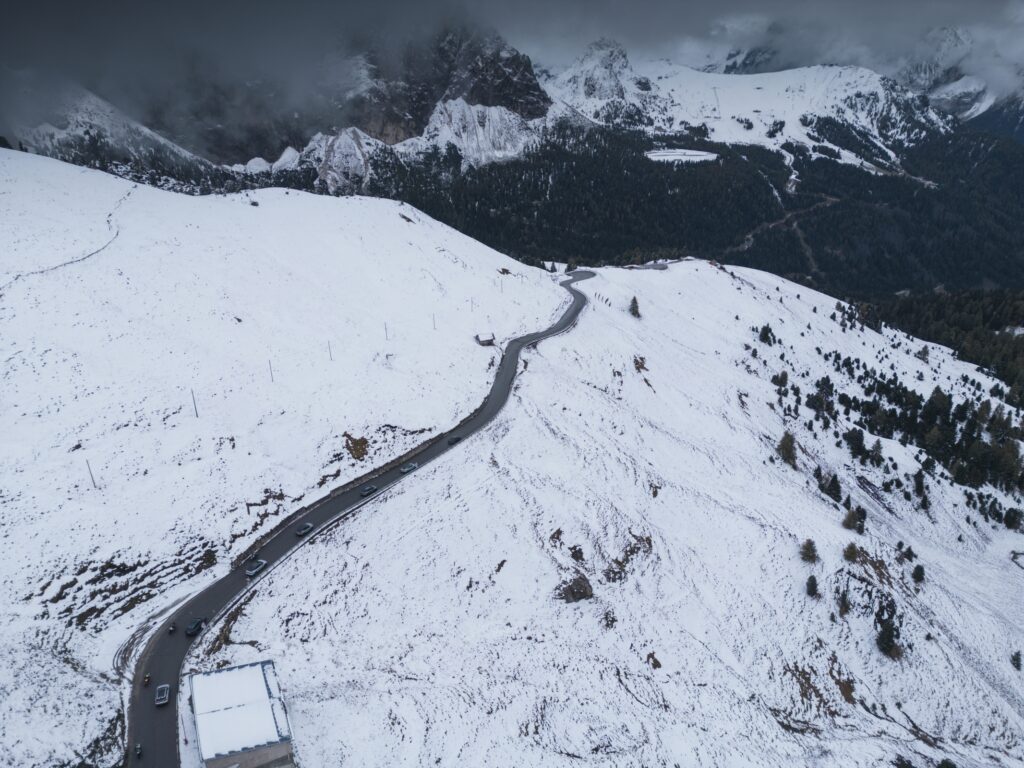
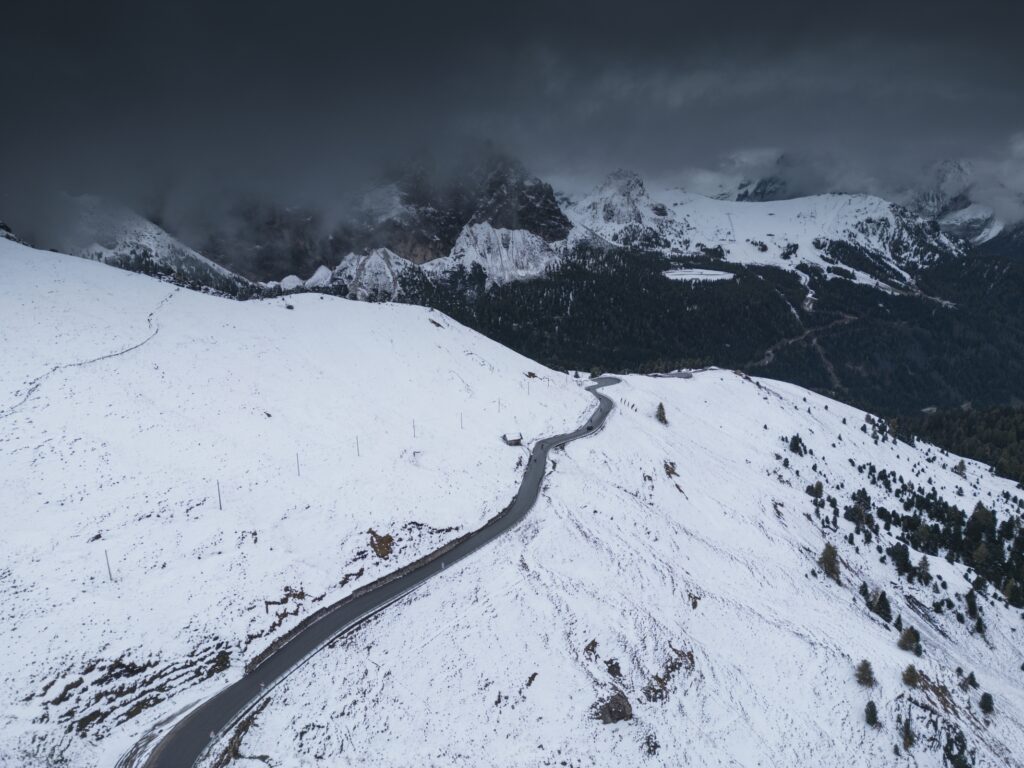


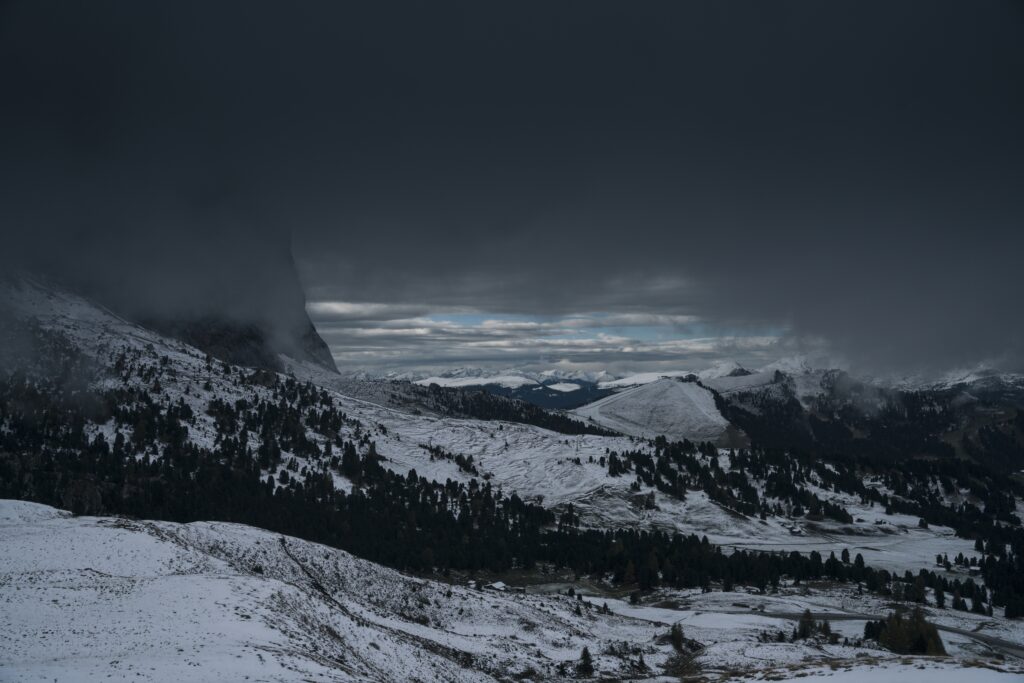

And because we deserved a little sunshine on our driveway, it came, so we set off to where the clouds reach – the Sella Pass. So we went to meet the clouds at 2,218 meters.
The end of the day regrouped us at Hotel Monroc, where we discovered two things. A beautiful place and the fact that despite a tough route with many differences in level, the models had the most fuel-efficient day.
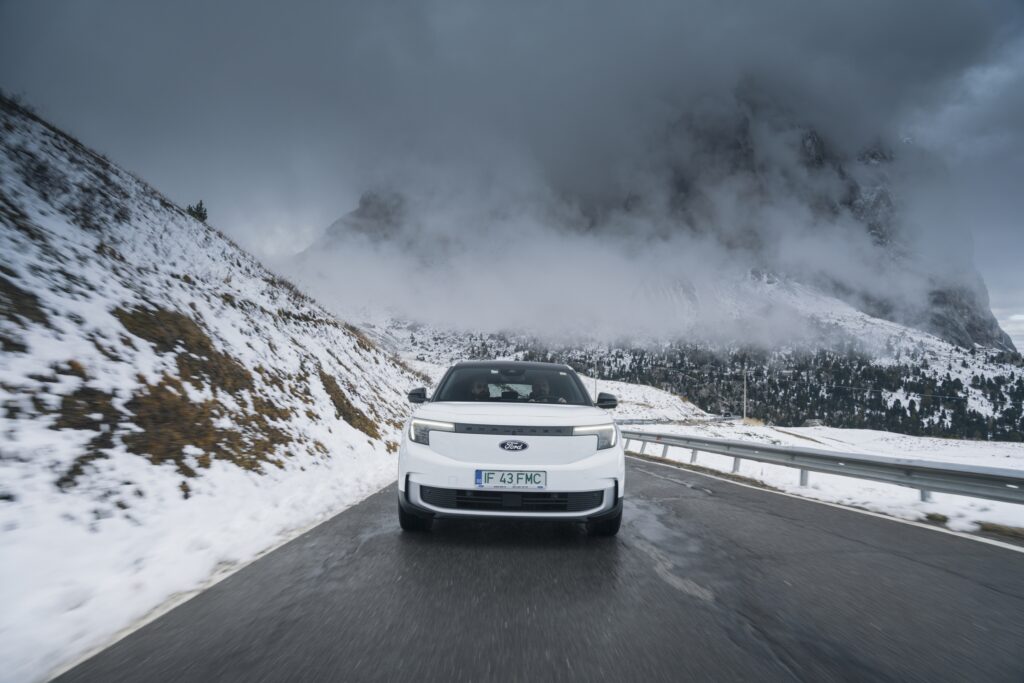
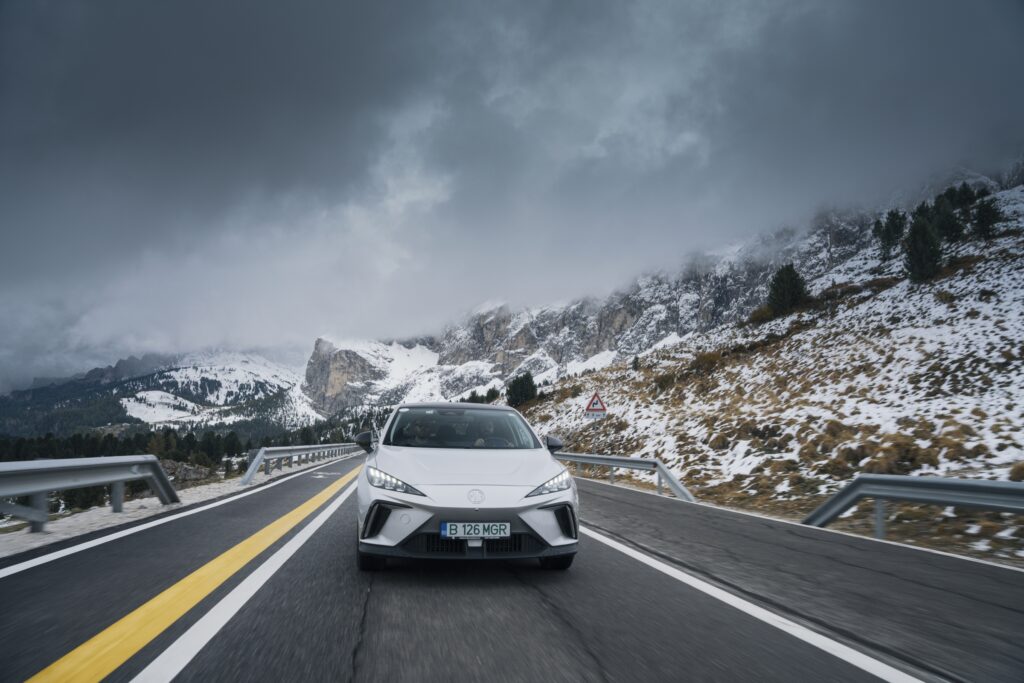
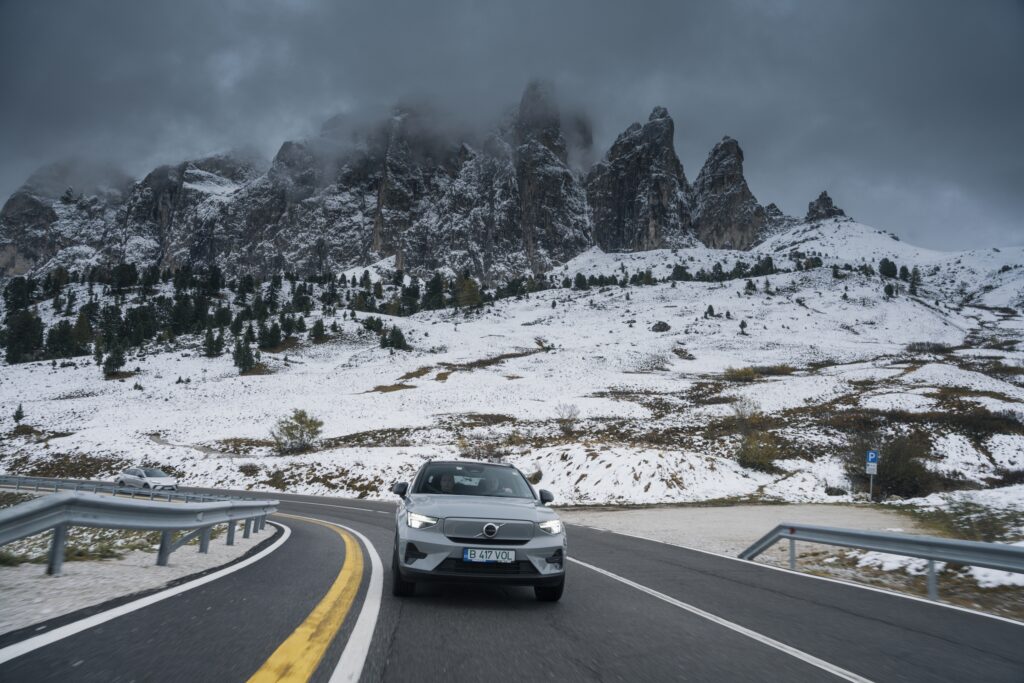
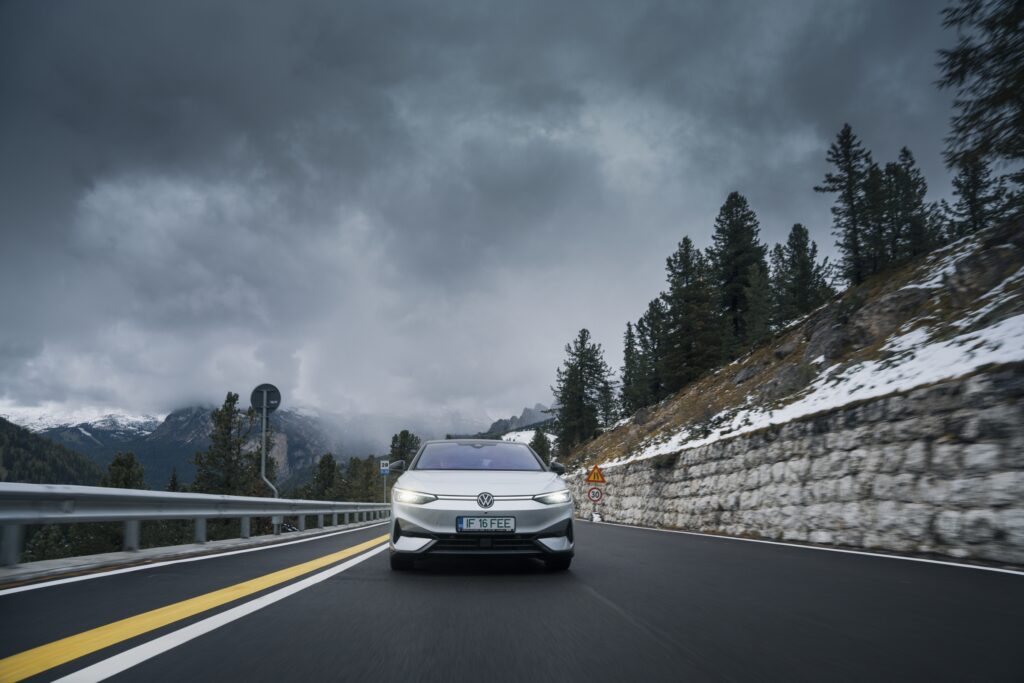
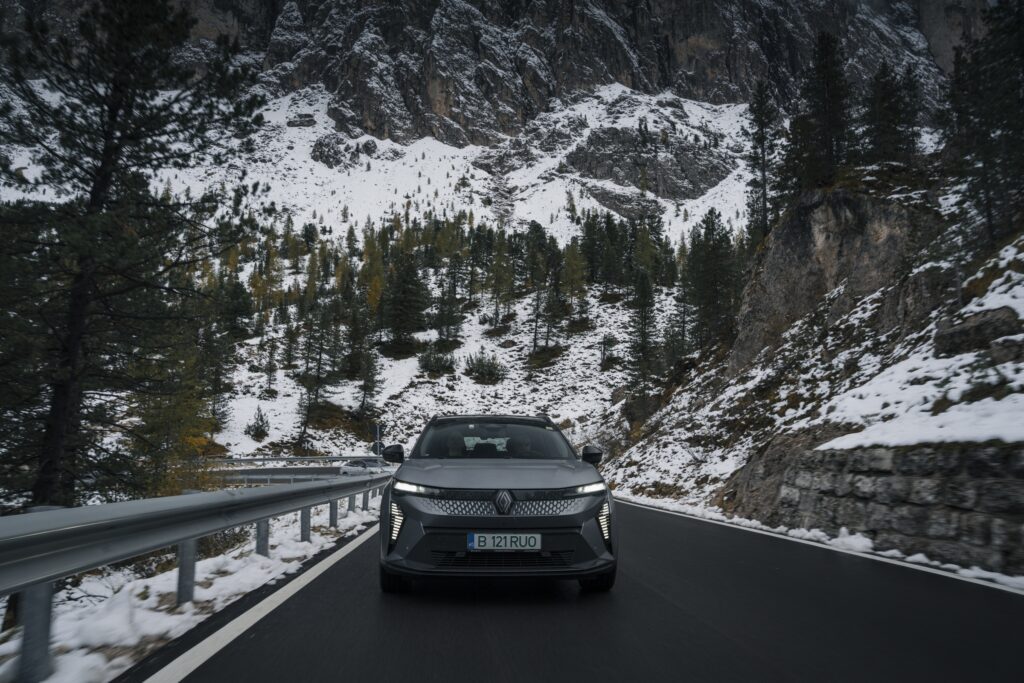
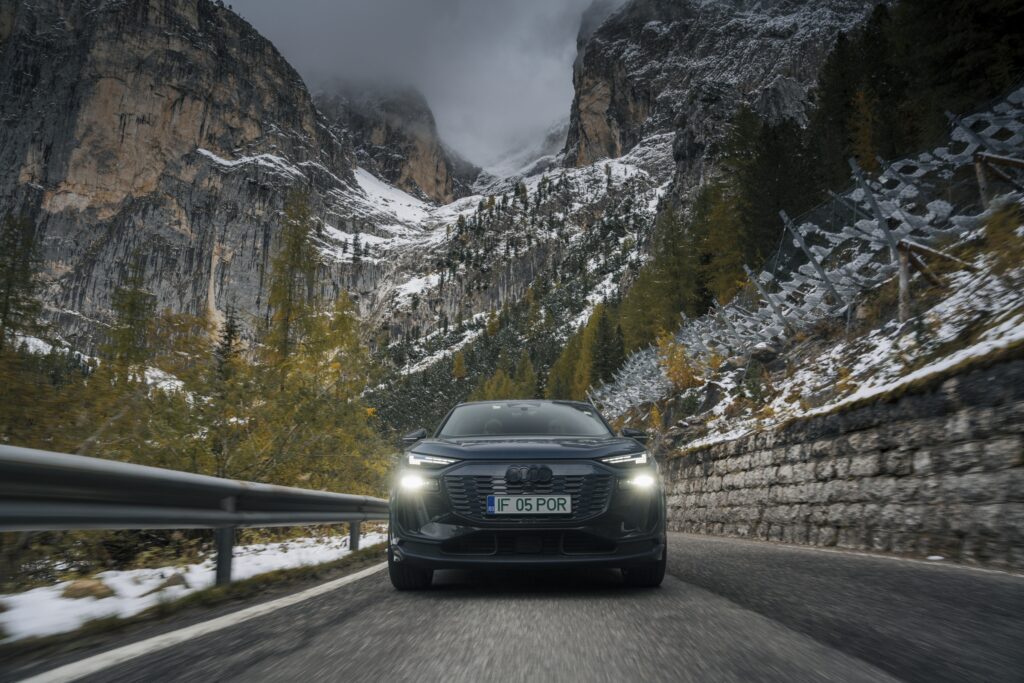
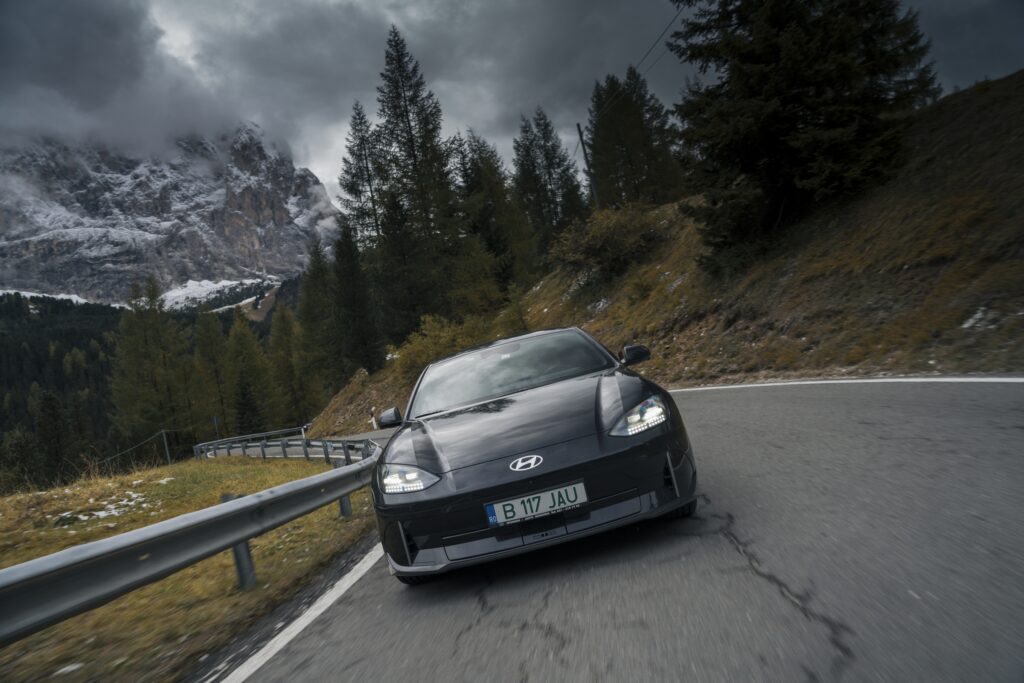
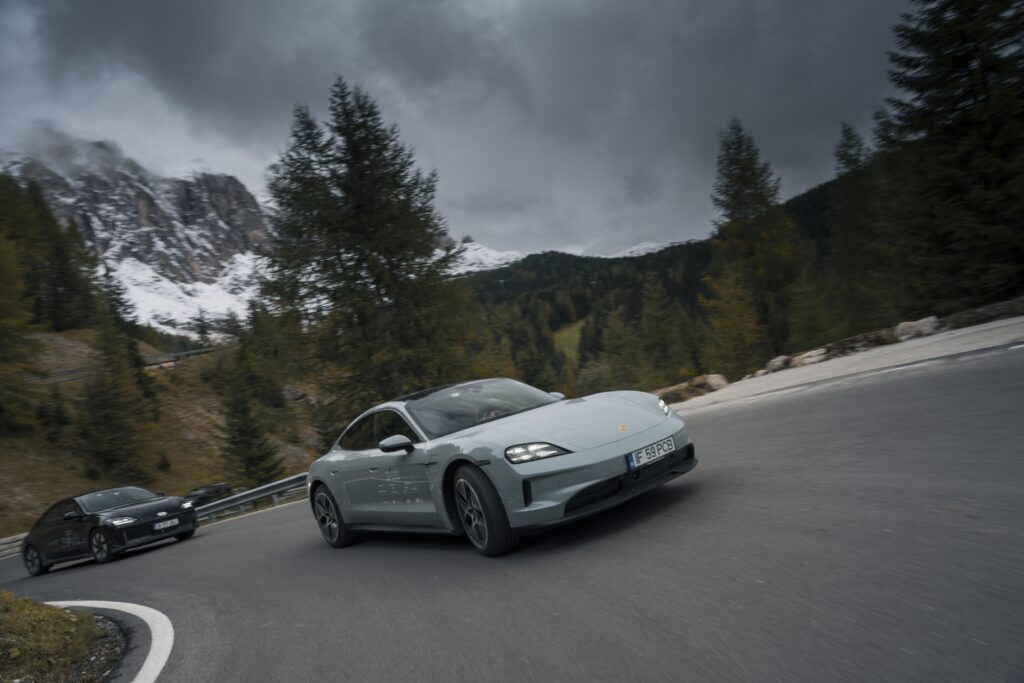

Gabriel Nica(With and About Cars)
about Audi Q6 e-tron
Beginnings are always hard, and Audi is now going through a reinvention phase almost from scratch. The electric era looms in the distance, and it seems to have no patience for any automaker, especially when there’s an oriental wind blowing in your face.
I like to say that thermal and electric cars are completely different species. However, there’s always something familiar about traditional car manufacturers’ cars. In the case of the Q6, it’s the comfort and refinement of the finished product that is that ‘familiarity’.
During the two days and about 600 kilometers driven in the Audi A6 e-tron, I understood that the Iugolstadt-based company wanted to preserve much of the character of the cars that have made them famous. It’s a model with a level of refinement that’s hard to match, with all the technology you need today, but also with some “quirks” that could have been forgotten.
Perhaps a splash of color inside would have been a breath of fresh air. Maybe the seats could have been more comfortable, and maybe Audi would have been better off not falling into the modern trap of adopting ergonomically unsound solutions just because they look “modern”.
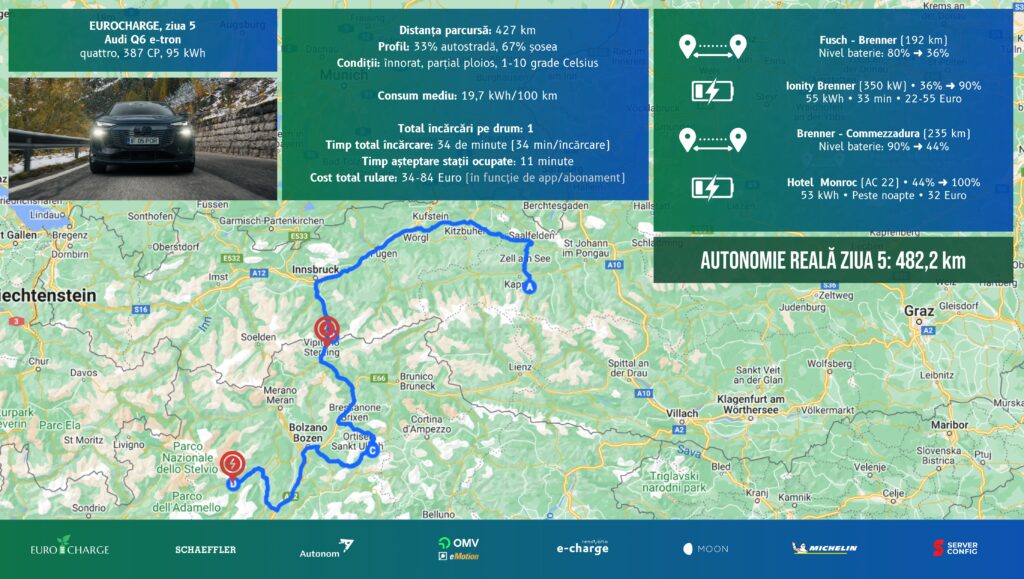
Dan Scarlat(Top Gear Romania)
about Ford Explorer
The Ford Explorer is truly a combination of American design and European technology, but it’s not so much Ford Europe’s (although this is the first Ford electric model built in Europe), but one supplied by the Volkswagen Group, as the new Explorer takes over the “MEB” technical platform. The decision is based on a wider strategic agreement between Ford and Volkswagen, officially announced as early as 2020.
Fortunately, the new Explorer isn’t just “badge engineering” based on the VW ID.4. In fact, the bodywork is completely new and not even the mirrors or glass surfaces are taken from Volkswagen. And that’s a good thing, because the Explorer looks like a genuine Ford, with a front end inspired by the American electric pick-up F-150 Lightning and a rear similar to the Explorer PHEV (which is still available in Romania). Personally, I’d dare to say it has even more personality than its German “cousin”, the ID.4.
The interior is also completely different, at least in shape. The Explorer has a modern “flattened” steering wheel and a large 14.6-inch center display that’s vertically positioned and slideable, allowing both tilt-angle adjustment and access to a hidden compartment that can be very useful. However, there are many controls carried over from the ID.4 (mostly tactile), which take some getting used to, whether you come from the Ford universe or not. The interior looks good and is bright. Our setup includes a panoramic roof and a black/white color scheme. Materials are in the normal Ford sphere, a combination of different quality plastics, “Sensico” leather (in “Premium” trim) plus textile elements. To criticize would be the seats, which aren’t the most ergonomically shaped, and the limited space in the back seat for taller adults. Antifouling is average, but the car is well optimized aerodynamically – so on worse roads you’ll hear some noises from the drivetrain area, but at higher speeds the atmosphere is quiet.
The Explorer has a single engine driving the rear axle, 286 hp, which gives it the acceleration of a sports car from 10-20 years ago. The maximum 135 kW (DC) top speed is the lowest of the cars in #EUROCHARGE, but otherwise the car’s efficiency is commendable, especially for an SUV. On the fifth day of the tour, the Ford averaged 16.2 kWh/100 km on a mixed route that included highway, national roads, and mountainous serpentines, resulting in an actual range of 475.3 km. Not bad.
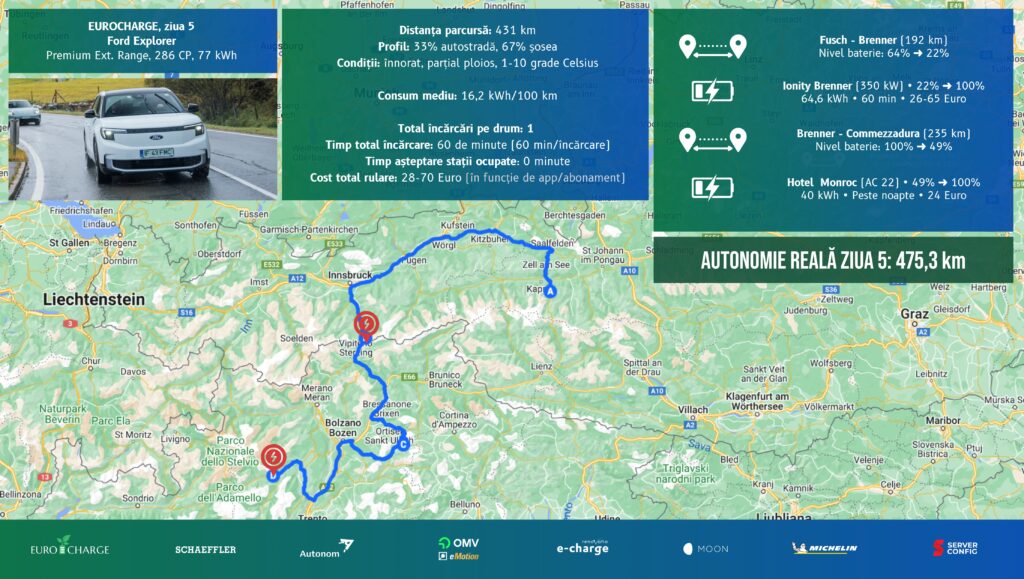
Tudor Rus (Autocritica)
about Hyundai Ioniq6
The Hyundai Ioniq 6 is a curiously… good concept (not in the prototype sense). We know, it’s easier to get lost in the internecine banter picked up from the front of the block stairs, and harder to go to a dealer for a test drive.
Listen to me for a minute.
When it comes to attention and dedication to all things dynamic (not in the tire-grinding, tire-firing sense), the Ioniq 6 is on the level of a sports car. That it’s no sports car is clear, but the sum of the steering, suspension (slightly more fibrous than the Ioniq 5), chassis and braking/acceleration response is the definition of balance.
Yeah, but it’s a weird shape.
Yes, it does. Largely functional: in the long run and at the right speed, how the air falls on the dashboard will pay off on the efficiency side.More the graphs below will tell you, I can relate to the route that befriended me with the Ioniq 6 (yes, I’m that X5 40d support guy): 183.9 km from breakfast to noon, on Austrian roads, within the limits of road legislation, with a stint on a highway with compressed roadworks traffic. Consumption: 14.4 kWh/100 km. Enough for a range of over 500 kilometers.
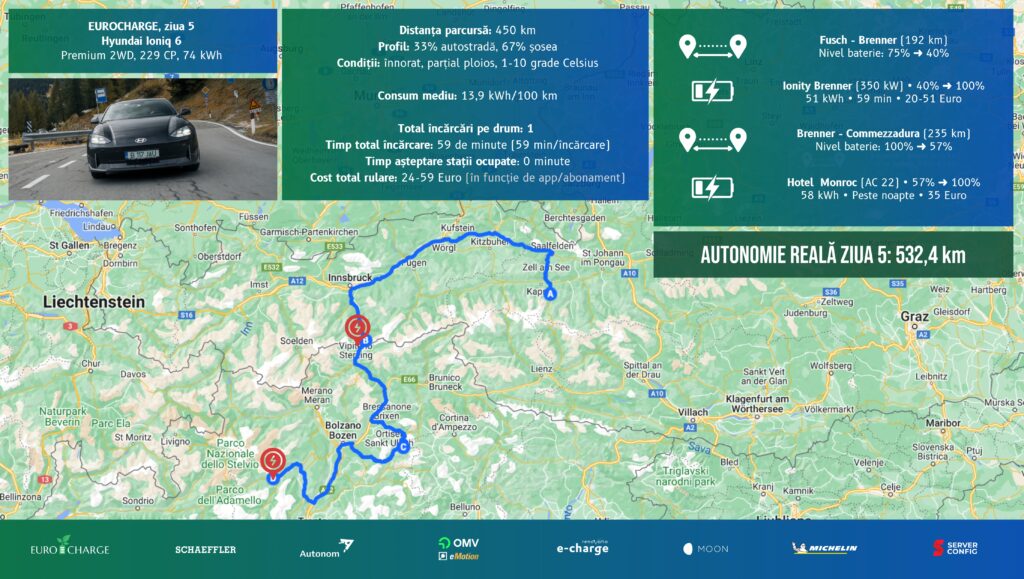
Tiberiu Buzdugan(electromobilitate.com)
about MG4
Until Eurocharge, I’d never gotten into an MG model. All I knew about the brand was that it was very popular in the UK and that for more than 10 years the cars have been made in China. Recently, they’ve also appeared on the Romanian market, gaining market share mainly thanks to the thermal variants, which are very competitively priced.
MG4 is developed on a platform designed from scratch for electric cars, called MSP (Modular Scalable Platform). The main advantages are equal mass distribution between the two axles and a very low center of gravity. When driving, this translates into agile handling, making every corner a pleasant experience. From the very first corners on the Austrian Alpine country roads, I was surprised how responsive the suspension was. Although comfortable, it holds the car well on the road, without a feeling of roll.
Inside, I liked the seats, which I found even a little more comfortable than the Ioniq 6, even though they had no lumbar adjustment. After 6 and a half hours on highways and mountain roads, I felt fresh, with no neck or back pain. The storage spaces are generous and well thought out, with plenty of room between the seats, under the armrest and in the doors. The quality of interior materials is above expectations for a car in its class. Although many surfaces are plastic, the areas you normally touch are pleasant and feel durable. Trunk space is small, but that’s to be expected for a car in this class.
Adaptive cruise control takes a little getting used to, but after a few hundred miles you start to anticipate what it’s going to do. It has small shortcomings, such as braking unnecessarily in curves without traffic or reacting too cautiously when cars in front of you touch your lane. However, in difficult weather conditions (heavy rain, fog and darkness), it detected the pavement markings very well and held its lane exemplary. I also appreciated the headlights which, although not adaptive, matrix LED or other “modern” stuff, beat quite well and without disturbing other cars in traffic.
One notable minus is hiding climate controls in the infotainment screen, an irritating trend that more and more manufacturers are following. When using Apple CarPlay or Android Auto, having to navigate through multiple menus to adjust the climate control is impractical and goes against any idea of considerate driving.
Although the MG4 is compact in size, it’s quite heavy and not very efficient, but the large 77 kWh battery provides a decent range (over 300 km on the highway and over 400 km on national roads). The charging speed is not at the level of other 2024 electric cars, but for daily use or shorter trips, this won’t be a major issue. Of all the variants available, the single-motor model with the 77 kWh battery (the one we tested) seems to me to be the most suitable as an all-round car.
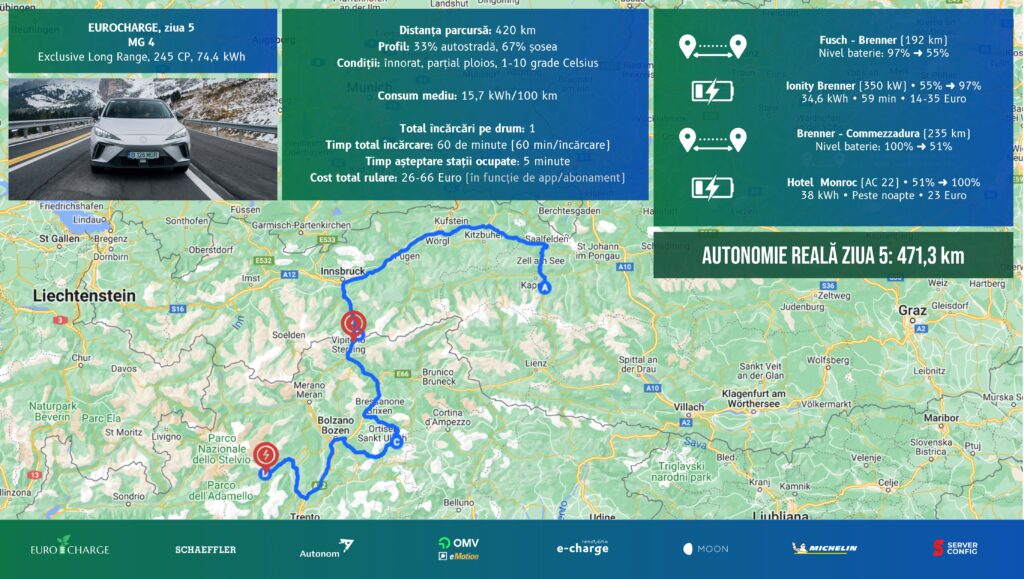
Laura Antonov (LaChicBoutique)
about Porsche Taycan
Girls, if you’re wandering around Autocritica.ro, know that the Porsche Taycan is just like that guy you like at first sight and then it takes your mind as you discover it. Because it ticks everything off the list and it has absolutely no red flags. So far, the three days we’ve had the Porsche Taycan have been the wettest in Eurocharge.
And when I say rainy, you have to mean that dreary fall-winter weather that nobody can stand. The very weather that kept us from climbing the Grossglockner. Still, I quickly realized you can’t have a bad day driving a Taycan. Especially as on my list, the Porsche Taycan ticked pretty much everything there was to tick.
It looks good, runs well, loads fast (faster than I eat a whole pizza for lunch) and makes me smile. Yes, I could write about the figures here too, but you can see them in the table, we fill them in religiously every day.
But I realized that the Porsche Taycan isn’t all about the numbers. It’s not even about how much it costs, even if it is the most expensive car on the tour. It’s all about the feel! It handles beautifully on twisty mountain roads, but also on the highway or in the city, effectively floating despite its 2.5 tons…
What have I left with after almost three days driving the Porsche Taycan? I realized that you quickly get used to the things you like and it’s hard to part with them. But, because there’s a but, now that I’ve seen the Taycan, I can’t help but wonder about the Taycan Turbo GT.
Yeah, yeah I know, I sound disgruntled anyway.
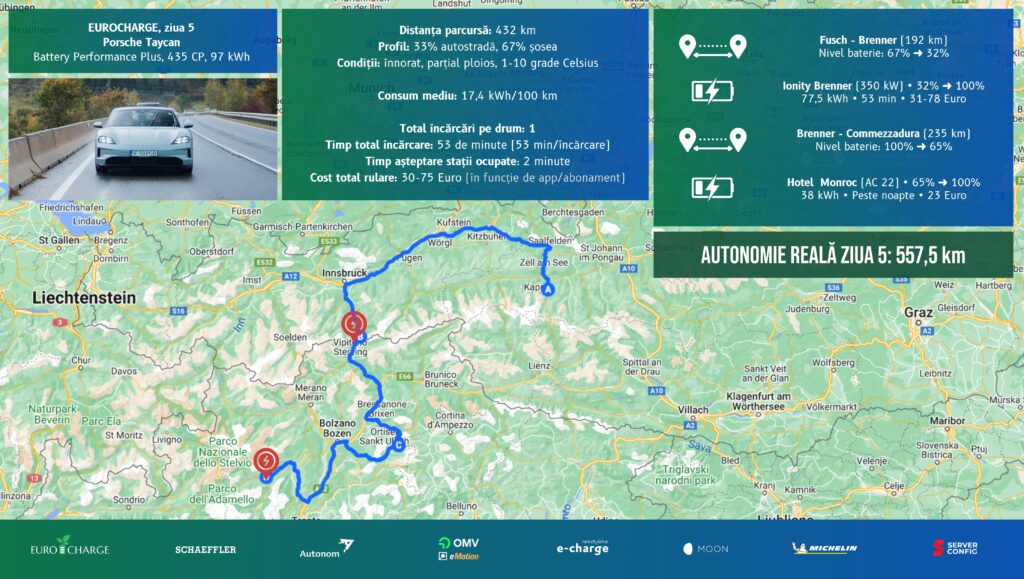
Julius Constantinescu (Digital Storyteller)
about Renault Scenic
The Renault Scenic is a solid, roomy and extremely easy to drive SUV – probably one of the best options in the 50k price bracket in any engine type, not just an electric. The suspension is great, it absorbs shocks so well, if you’re doing the road in Tony Soprano’s trunk you probably won’t even know when you’ve exited the highway and entered the forest road.
I’d also note one thing about the Scenic that no other car has: the Harman/Kardon sound system customized by Jean Michel Jarre. It sounds so good that I ironically put on Florin Salam, and the Scenic’s sound system ironically played Pink Floyd.
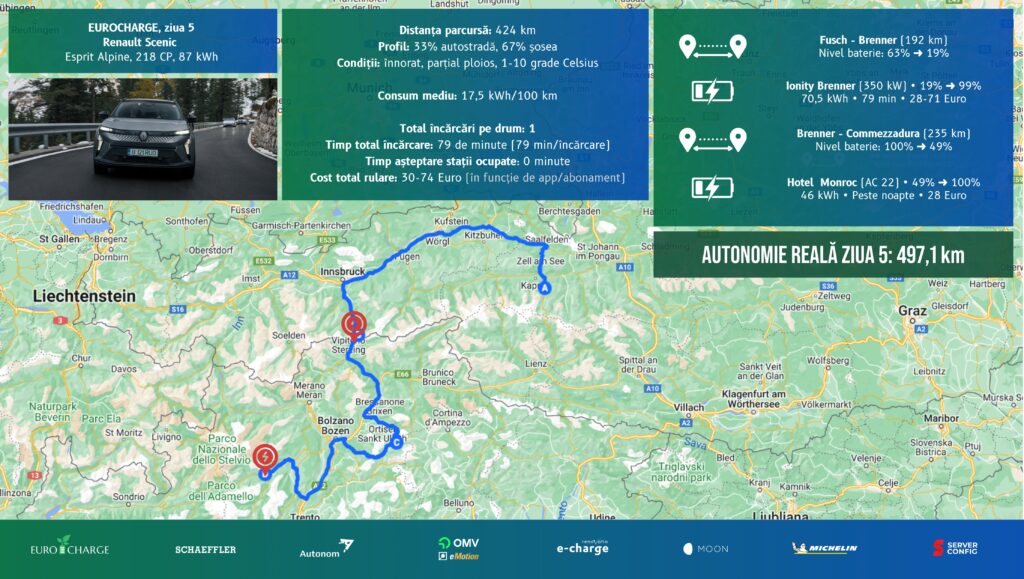
Mihai Vasilescu(mihaivasilescu.ro)
about Volkswagen ID.7
I played for two days with Volkswagen ID.7 and I really enjoyed doing that. But first things first.
Because when it comes to electric cars, the first question you get is “how long does the battery last?”, I’ll start by answering it. I wouldn’t have started with that if the ID.7 didn’t make me raise an appreciative eyebrow. I don’t know how the Germans did it, but the energy recovery system on this car is very efficient. Maybe I wouldn’t have realized it if I hadn’t been driving it right after the Renault Scenic, which also has a very well-developed energy recovery system.
But in doing so, I was able to see exactly how well the ID.7, which is almost in the same parameters as the Scenic, does the job, except that being about 300 kg heavier means it recovers energy more efficiently.
In short, I played with it for two days. I drove on highways, on normal roads, on winding mountain roads, up, down, in all possible driving modes, and this car never for a moment dropped below 400 km range.
On the first day it had an average consumption of 19.1 kWh/100 km and an actual range of 403 km, and on the second day an average consumption of 16.1 kWh/100 km and an actual range of 478 km (proof below). Not bad at all, eh?
Now that we’re done with the “how long will the battery last?”, I’ll just say that I like the looks of this car. I like it a lot. I’ve driven the ID.4 and ID.5, of the previous generations of IDs, but neither of them blew me away aesthetically. What I can’t say about the ID.7.
The car is very nice, the Germans were very inspired when they changed from that compact SUV shape to a sedan. It’s still a family car, but much cooler. Don’t knock it, it’s my opinion, it’s subjective, we all know (especially those of us with ugly wives 😛), that beauty is in the eye of the beholder.
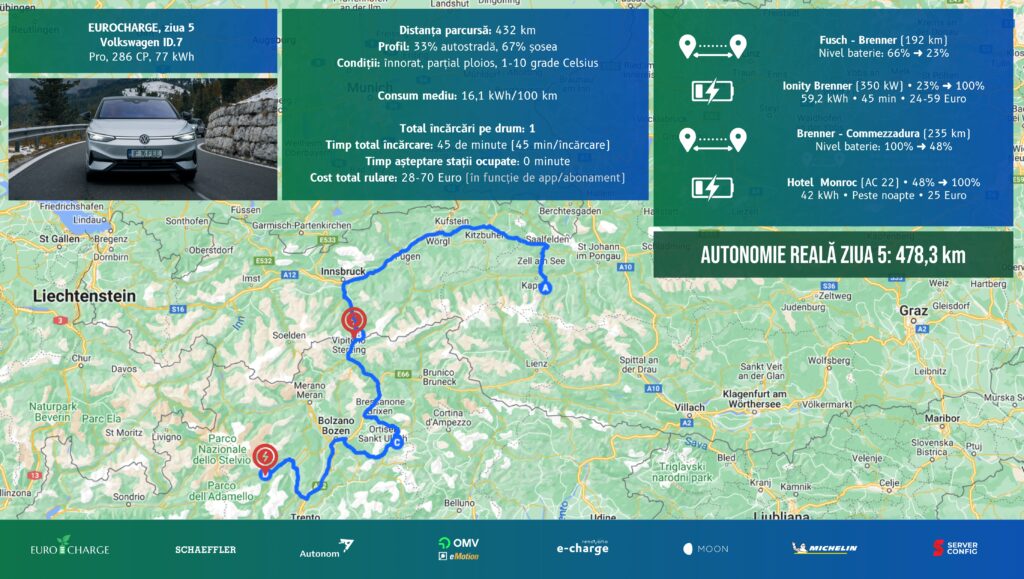
Berti Panaiot (Autocritica & Urban Adventures)
about Volvo EX40
After the first contact, where I was pleased that all our luggage for the 16-day tour fit in the trunk, now, after 2,000 kilometers, I’ve discovered many more things I like about the Volvo EX40.
Let’s start with the design: I like simple things with a focus on functionality, and in this respect the Volvo EX40 ticks all the boxes I need right now. I got into the Volvo EX40 and felt right at home. All the buttons and knobs were where they should be, the infotainment system super intuitive, I quickly plugged in my phone and hit the road.
The Swedes must have some kind of seventh sense whereby they manage to simplify things a lot, but without making them trivial. Because you can say anything you like about the Volvo EX40, but it’s not banal. Not on the outside and not on the inside.
I really like the on-board instrumentation, and I find the vertically-positioned center screen much better integrated than in the EX30, for example. The EX40 comes with the Android Automotive OS, meaning you have all the Google apps already installed, but Apple Car Play works seamlessly if you’re more into iOS. And the fact that it already has Spotify installed and quickly connected me with my account, is as the English would say “music for my ears”.
For the loading part, fuel consumption, costs or anything else you can think of you’ll have to wait a bit longer. Because I’ll be driving the Volvo EX40 for all 16 days, so we have time to get better and better friends. And you can kind of tell how it’s been from each day’s “technical” sheet anyway.
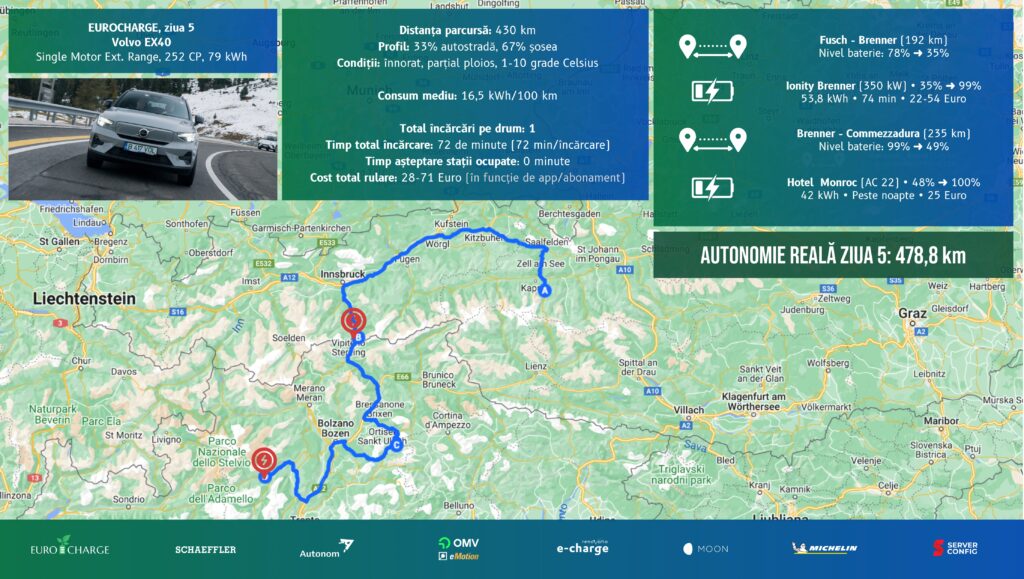
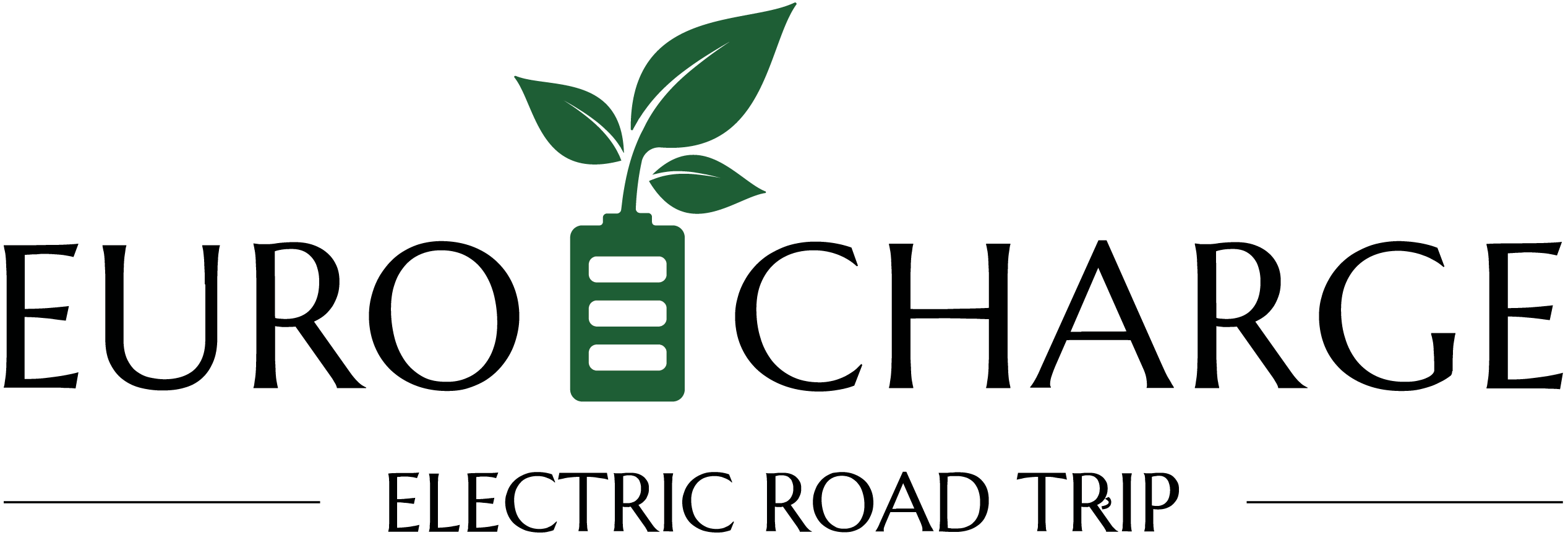
is a project backed by SCHAEFFLER
Charged by
OMV eMotion and Renovatio e-charge
Green Partner
Autonom
Charging stations
MOON România
On the road with
Michelin
Powered by
Server Config



